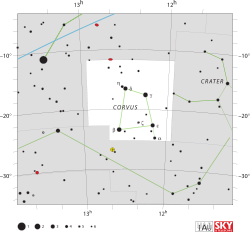Epsilon Corvi
| Observation data Epoch J2000 Equinox J2000 |
|
|---|---|
| Constellation | Corvus |
| Right ascension | 12h 10m 07.48058s |
| Declination | –22° 37′ 11.1620″ |
| Apparent magnitude (V) | +3.024 |
| Characteristics | |
| Spectral type | K2 III |
| U−B color index | +1.458 |
| B−V color index | +1.318 |
| Astrometry | |
| Radial velocity (Rv) | +4.9 km/s |
| Proper motion (μ) |
RA: –71.74 mas/yr Dec.: +10.25 mas/yr |
| Parallax (π) | 10.26 ± 0.16mas |
| Distance | 318 ± 5 ly (97 ± 2 pc) |
| Absolute magnitude (MV) | −1.82+0.15 −0.14 |
| Details | |
| Mass | 3.2 M☉ |
| Radius | 52 R☉ |
| Surface gravity (log g) | 2.16 cgs |
| Temperature | 4320 K |
| Metallicity [Fe/H] | –0.13 dex |
| Rotational velocity (v sin i) | 1.0 km/s |
| Other designations | |
Epsilon Corvi (ε Crv, ε Corvi) is a star in the southern constellation of Corvus. It has the traditional name Minkar, from Arabic المنخر al-mánxar meaning "the nostril of the crow" The apparent visual magnitude is +3.0 and it is located at a distance of 318 light-years (97 parsecs) from Earth.
In Chinese, 軫宿 (Zhěn Sù), meaning Chariot (asterism), refers to an asterism consisting of ε Corvi, γ Corvi, δ Corvi and β Corvi. Consequently, ε Corvi itself is known as 軫宿二 (Zhěn Sù èr, English: the Second Star of Chariot.).
Epsilon Corvi is a red giant with a stellar classification of K2 III, having consumed the hydrogen at its core and evolved away from the main sequence. It has about three times the Sun's mass. The interferometry-measured angular diameter of this star is about 4.99 mas, which, at its estimated distance, equates to a physical radius of about 52 times the radius of the Sun. The effective temperature of the outer envelope is 4320 K, giving it an orange hue that is characteristic of a K-type star. Around 4 times as massive as the Sun, it spent much of its life as a main sequence star of spectral type B5V.
...
Wikipedia

